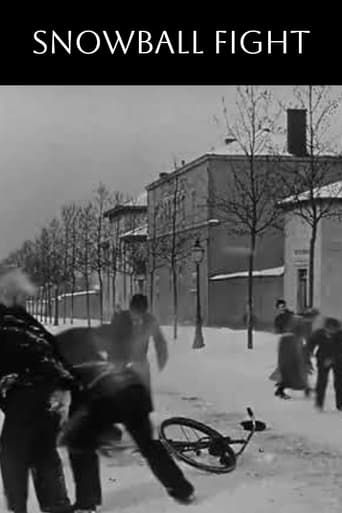Michael_Elliott
Bataille de neige (1897) This fifty second film from Louis Lumiere has a group of people throwing snowballs in the street. At first they're not aimed at anyone but soon a man comes along riding a bicycle. BATAILLE DE NEIGE is one of the best known films from Lumiere, which is easy to understand why since the image of people throwing snowballs is just downright fun. Even when viewing this film today you can't help but watch it with a smile as it's clear everyone is having a good time and we're given a twist with a minor subplot involving the bicycle rider. Yes, it's certainly nothing special by today's standards but for 1897 it offers something more than just one thing playing out.
Snow Leopard
This brief footage of a snowball fight is both fun and funny. It gives a convincing appearance of spontaneity, but at the same time the camera field catches so much that it seems quite likely that at least some planning was involved. In either case, it's one of the lightest and most amusing of the early Lumière features.The participants include both men and women, most of them rather nicely dressed. Watching adults unashamedly romping around like this is good fun, and it's hard not to think of Laurel and Hardy or other similar performers. Indeed, the bicyclist who happens onto the scene would have fit right in as a character in a Laurel and Hardy comedy.As you expect with Lumière, the photography is good, but this time it is the amusing antics that will make this one memorable.
Alice Liddel
This is a wonderful short depicting a snowfight on the streets of a French town. Two of the great masterpieces of European cinema - 'Les Enfants Terribles' and 'Amarcord' - have crucial scenes involving snowfights: this is the source of such a resonant set-up. This is arguably the first film to actually utilise the properties of monochrome, the brilliant white contrasting with the black chaos it contains.Although the film seems to embody a kind of anarchy, where all distinctions - class, age, gender etc. - dissolve in an egalitarian melee. 'Bataille', as with so many of the Lumieres' films is essentially conservative. Overlooking this alarmingly fluid mass are the fixed realities of place, home, property, and the bare trees, suggesting the inexorable order of nature and society.The snowfight, therefore, is not an overthrowing of the old repressive social order, but an example of what Bakhtin called the 'carnivalesque', one of those occasions set aside by societies (eg festivals, parades etc.) where the norm is overthown, where the peasant becomes king and vice versa; where there is a break from the norm, a playing at difference of status, before returning to the old routine and social relations. This is visualised in the fixed gaze of the camera, which keeps whole all the fragmentation it observes. Beautiful.

